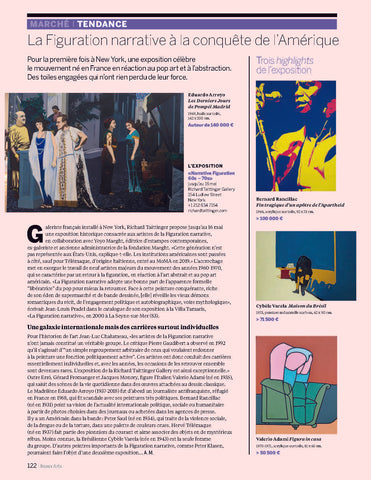Press - Narrative figuration.
Narrative Figuration conquers America, the movement born in France in reaction to pop art and abstraction. Committed canvases which have lost none of their strength.
Eduardo Arroyo The Last Days of Pompeii Madrid
1969, oil on canvas, 142 x 200 cm.
Around €140,000
THE EXHIBITION
“Narrative Figuration 60s – 70s”
until May 16
Richard Taittinger Gallery 154 Ludlow Street
new York
+1 212 634 7154
richardtaittinger.com
The Beaux-Arts Magazine article here
French gallery owner based in New York, Richard Taittinger is offering a historic exhibition until May 16 dedicated to the artists of Narrative Figuration, in collaboration with Yoyo Maeght, publisher of contemporary prints, ex-gallery owner and former administrator of the Maeght foundation. “This generation is not represented in the United States,” she explains. “American institutions have missed out, except for Télémaque, of Haitian origin, who entered MoMA in 2019.”
Bernard Rancillac
Tragic end of an apostle of Apartheid
1966, acrylic on canvas, 92 x 73 cm.
> € 100,000
The exhibition highlights the work of nine major artists of the movement of the 1960s and 1970s, which is characterized by a return to figuration, in reaction to abstract art and American pop art. "Narrative Figuration adopts a good part of the formal “liberating” appearance of pop to better turn it around. Faced with this conquering painting, rich in its supermarket and comic book Eden, [it] awakens the old romantic demons of narrative , of political and autobiographical, even mythological, commitment", wrote Jean-Louis Pradel in the catalog of his exhibition at the Villa Tamaris, "La Figuration narrative", in 2000 in La Seyne-sur-Mer (83).
Cybele Varela
House of Brazil
1973, industrial painting on wood, 62 x 90 cm.
> €71,500
An international galaxy but above all individual careers
For the art historian Jean-Luc Chalumeau, "the artists of Narrative Figuration have never constituted a real group. The critic Pierre Gaudibert observed in 1992 that it was a simple arbitrary grouping of those who wanted to restore to painting a politically active function”. These artists therefore led essentially individual careers and, over the years, the opportunities to find them together became rare. The exhibition at the Richard Taittinger Gallery is therefore exceptional. » In addition to Erró, Gérard Fromanger and Jacques Monory, there is the Italian Valerio Adami (born in 1935), who captures scenes of daily life in works linked to classical drawing.
Valerio Adami
Figure in house
1970-1971, acrylic on canvas, 81 x 65 cm.
> €50,500
Madrilenian Eduardo Arroyo (1937-2018) was first an anti-Franco journalist, taking refuge in France in 1958, who caused a scandal with his very political paintings. Bernard Rancillac (born in 1931) paints his vision of international political, social or humanitarian news from photos chosen from newspapers or purchased from press agencies.
There is an American in the band: Peter Saul (born 1934), who deals with social violence, drugs and torture, in a palette of harsh colors. Hervé Télémaque (born in 1937) is one of the pioneers of the movement and likes to combine objects into mysterious puzzles. Less known, the Brazilian Cybèle Varela (born in 1943) is the only woman in the group. Other important painters of Narrative Figuration, such as Peter Klasen, could be the subject of a second exhibition…
Our insurgents favorites
Focus on three painters major of there Figuration narrative, Or scenes of there life daily, sequences of movies, leaflets Or bands drawn nourish of the works below high tension social And policy.
Gérard Fromanger (born in 1939)
The colorist
F l o r e n c e ,
r u e d ' Or c h a m p t
1975, oil on canvas, 130 x 97 cm.
The artist, an active activist in the popular Beaux-Arts workshop during May 68, used photos of passers-by or urban scenes in the 1970s that he projected onto his canvas.
“Painter of the anger of the world”, he generally only keeps characters' silhouettes, which he reworks into flat areas of color – often a flamboyant red, his favorite shade, as in his famous Boulevard des Italians series. He also produced “film-tracts” with Jean-Luc Godard and portraits of his friends (Jacques Prévert, Michel Foucault, etc.). From 1978, Fromanger painted directly on the canvas, without image projection. His first retrospective at the Center Pompidou, “Everything is lit”, dates from 1980, the last from 2016.
Erró (born 1932)
The accumulator
Originally from Iceland, Erró moved to Paris in 1958 and became one of the leaders of Narrative Figuration. The artist accumulates images from his travels all over the world: photos, advertisements, comics, cinema posters, leaflets...
He assembles these documents into small collages which are like models for his large painted compositions. His saturated canvases are constructed according to incredible perspectives and scales. Critical of consumer society and systems of oppression, they trigger real visual shocks, between humor and violence.
Erró is represented by the galleries Louis Carré & Cie (Paris) and Perrotin (Paris-New York-Hong Kong-Seoul-Tokyo-Shanghai).
From a few thousand euros for a collage and up to more than €300,000 for a large painting
Jacques Monory (1924-2018)
The movie buff
T ec h n ico lo r n o 2 3
1977, oil on canvas,
150x150cm.
Jacques Monory is a pioneer of the movement. From the start
from the 1960s, he works from photographic images taken by himself or selected from film magazines. Fascinated by the 7th art, he paints large canvases, often cut into several parts, like cinematographic sequences. The monochrome background, generally blue, but also yellow, pink or black, reinforces the dreamy atmosphere.
The artist often represents himself in his works, hero or hitman, victim or simple witness. Jacques Monory uses offset framing, the juxtaposition of images or the insertion of mirrors riddled with bullet holes, to better trap the viewer. From 1977, he abandoned monochromy for a blue-yellow-pink trichromy.
Jacques Monory is exhibited by the Richard Taittinger gallery (New York).
From €20,000 to €150,000 depending on the format
blupro










